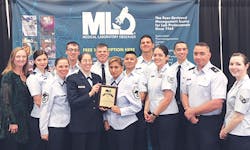Allergies in America
30 percent
Is the proportion of adults estimated to suffer from allergies in the U.S.
40 percent
Is the proportion of children estimated to suffer from allergies in the U.S.
50 million
Is the estimated number of people who have nasal allergies in the U.S.
17.6 million
Is the number of adults in the U.S. with hayfever. (2012).
6.6 million
Is the number of children in the U.S. with hayfever. (2012).
11.1 million
Is the number of people diagnosed with allergic rhinitis. (2012).
200,000
Is the number of annual Emergency Room visits linked to food allergies.
10,000
Is the number of annual hospital admissions linked to food allergies.
4 million
Is the number of children in the U.S. with food allergies. (2014).
8.8 million
Is the number of children in the U.S. with skin allergies. (2012).
40
Is the number of people who die in the U.S. each year from insect sting reactions.
Source:Asthma and Allergy Foundation of America Allergy Facts and Figures: http://www.aafa.org/page/allergy-facts.aspx
Zika Virus
Almost one in 10 pregnant women in the United States with ZIKV had a baby with birth defects. Of the 250 pregnant women who had confirmed Zika virus (ZIKV) infection in 2016, 24—or almost one in 10—had a fetus or baby with Zika-related birth defects, according to a new Vital Signs report from the U.S. Centers for Disease Control and Prevention (CDC). This report is the first to provide the analysis of a subgroup of pregnant women in the U.S. with clear, confirmed test results of ZIKV infection.
Testing for Zika remains complex because there is a narrow timeframe for obtaining a positive laboratory result, and many infected people do not have symptoms that might motivate testing. For this reason, the CDC is monitoring all pregnant women with any evidence of recent Zika infection. In 2016, nearly 1,000 pregnant women from 44 states who completed their pregnancies had some evidence of a recent Zika infection and were at risk of having a fetus or baby with Zika-related birth defects. Most of these women acquired Zika infection during travel to an area where Zika was known to be present.
The findings from this report confirm the serious threat posed by ZIKV infection during pregnancy and the critical need for pregnant women to continue taking steps to prevent ZIKV exposure through mosquito bites and sexual transmission. The report also emphasizes the importance of healthcare providers screening all pregnant women for possible ZIKV exposure and testing and evaluating all infants born to women with evidence of Zika infection.
This report updates previously published estimates of the proportion of fetuses or babies with birth defects among pregnant women with possible Zika infection reported to the U.S. Zika Pregnancy Registry from January 15, 2016, to December 27, 2016, in the 50 U.S. states and Washington D.C. The Registry includes data from all U.S. states, DC, and all U.S. territories except Puerto Rico; pregnancies in Puerto Rico are monitored separately by the Zika Active Pregnancy Surveillance System. This report also highlights possible gaps in clinical evaluation and management of infants with possible congenital ZIKV infection.
Genetics/Genomics
A new marker is proposed for the most common form of ALS. A molecule found in blood and cerebrospinal fluid could serve as an indicator for the most common form of amyotrophic lateral sclerosis (ALS), offering a much-needed tool to measure disease outcomes in clinical trials, a new study reports. The study was published in Science Translational Medicine.
No effective treatments currently exist for ALS (Lou Gehrig’s disease), a neurodegenerative disorder that rapidly progresses from symptoms of weakness and muscle atrophy to complete paralysis and death within 30 months of the initial diagnosis in almost half of all cases. Despite more than 30 clinical trials since 1995, only one ALS treatment has been brought to market, and that compound, Riluzole, extends survival by only two to three months.
In this study Tania Gendron, PhD, of the Mayo Clinic, and colleagues demonstrated that a genetic change associated with the most common form of ALS—known as C9ORF72—also caused an abnormal protein called polyGP to accumulate in the cerebrospinal fluid (CSF) and blood cells of patients. The researchers detected polyGP in CSF from 134 individuals with the C9ORF72 form of ALS, including from 83 ALS patients, 24 people with diseases other than ALS, and 27 asymptomatic carriers.
Interestingly, polyGP was not found in CSF from 120 people lacking the C9ORF72 mutation, including 57 patients with a different form of ALS. What’s more, when the scientists administered a therapy targeting the C9ORF72 mutation in mouse models of C9ORF72 ALS, they observed reduced polyGP levels in the animals’ CSF.
The authors say that with further development, polyGP may prove to be a useful pharmacodynamic marker for therapeutic responses in clinical trials, especially for those patients who carry the mutation but are not yet symptomatic.
Diabetes
Children at risk of diabetes should be screened by HbA1C, OGTT. Doctors should add an oral glucose tolerance test (OGTT) to their hemoglobin A1C (HbA1C) when they screen high-risk children for prediabetes and diabetes, new South Korean research suggests.
“We recommend the combined use of fasting and two-hour glucose levels, in addition to HbA1C, for the diagnosis of childhood prediabetes and diabetes,” says first author Hyo-Kyoung Nam, MD, PhD. “Traditionally, plasma glucose levels obtained from oral glucose tolerance tests have been used to diagnose prediabetes and diabetes. Hemoglobin A1C, which is easy to use and does not require fasting, has recently been recommended as an
alternative diagnostic method in adults. However, using HbA1C to diagnose prediabetes and diabetes in children and adolescents is controversial.”
The research team evaluated the ability of HbA1C to diagnose prediabetes and diabetes and they established the optimal HbA1C cutoff points for detecting prediabetes and diabetes in youth. They reviewed the medical records of 217 obese boys and 172 obese girls who had undergone OGTT and HbA1C testing simultaneously between January 2010 and June 2016 in six hospitals. The children were diagnosed with prediabetes (fasting glucose 5.6 to 6.9 mmol/L; 2-hour glucose 7.8 to 11.0 mmol/L) or with diabetes (fasting glucose 7.0 mmol/L or higher; 2-hour glucose 11.1 mmol/L or higher).
All children with diabetes were detected using the combined OGTT and HbA1C tests. Roughly half of overweight children at risk had prediabetes or diabetes based on OGTT results, and the agreement between OGTT and HbA1C results was moderate.
The authors found that the optimal HbA1C cutoff points were 40 mmol/mol (5.8 percent) for prediabetes and 44 mmol/mol (6.2 percent) for diabetes.
“The usefulness of adult criteria of HbA1C for the diagnosis of prediabetes and diabetes in children and adolescents remains to be clarified due to disparities between the results of OGTT- and HbA1C-based tests,” Nam says.
Cancer
Cancer death rates continue to decline. Overall cancer death rates continue to decrease in men, women, and children for all major racial and ethnic groups, according to the latest Annual Report to the Nation on the Status of Cancer, 1975-2014.
The report finds that death rates during the period 2010-2014 decreased for 11 of the 16 most common types of cancer in men and for 13 of the 18 most common types of cancer in women, including lung, colorectal, female breast, and prostate cancers.
Meanwhile, death rates increased for cancers of the liver, pancreas, and brain in men and for liver and uterine cancer in women. The report finds overall cancer incidence rates, or rates of new cancers, decreased in men but stabilized in women during the period 1999-2013.
The Report to the Nation is released each year in a collaborative effort by the American Cancer Society; the Centers for Disease Control and Prevention (CDC) and National Cancer Institute (NCI), both parts of the Department of Health and Human Services; and the North American Association of Central Cancer Registries (NAACCR).
Compared to cases diagnosed in 1975-1977, five-year survival for cancers diagnosed in 2006-2012 increased significantly for all but two types of cancer: cervix and uterus. The greatest absolute increases in survival (25 percent or greater) were seen in prostate and kidney cancers as well as non-Hodgkin lymphoma, myeloma, and leukemia.
Cancers with the lowest five-year relative survival for cases diagnosed in 2006-2012 were pancreas (8.5 percent), liver (18.1 percent), lung (18.7 percent), esophagus (20.5 percent), stomach (31.1 percent) and brain (35 percent). Those with the highest were prostate (99.3 percent), thyroid (98.3 percent), melanoma (93.2 percent), and female breast (90.8 percent).
Infectious Diseases
Study suggests a new treatment for antibiotic-resistant bacteria and infectious disease. A recent study, published in the American Journal of Respiratory and Critical Care Medicine, describes a new treatment pathway for antibiotic-resistant bacteria and infectious diseases. Researchers from the University of Birmingham and Newcastle University found that the unusual approach of removing antibodies from the bloodstream reduced the effects of chronic infections, the requirement for days spent in the hospital, and the use of antibiotics.
In this study, the team identified two patients with bronchiectasis who suffered with chronic Pseudomonas aeruginosa infections that were resistant to many antibiotics: a 64-year-old male, diagnosed with bronchiectasis aged fifteen, and a 69-year-old female who had bronchiectasis from childhood.
Co-author Ian Henderson, PhD, explains: “These patients had an excess of a particular antibody in the bloodstream. In contrast to the protective effect normally associated with antibodies, in these patients the antibody stopped the immune system from killing the Pseudomonas aeruginosa bacterium, and this worsened the patients’ lung disease. Perhaps counter-intuitively, we decided to remove this antibody from the bloodstream, and the outcomes were wholly positive.”
The researchers used a process known as plasmapheresis, which, according to co-author Tony De Souza, MD, “involves “the removal, treatment, and return of blood plasma from circulation. We then replaced antibodies with those from blood donations. This treatment restored the ability of the patients’ blood to kill their infecting Pseudomonas.”
Both patients reported a rapid improvement in health and wellbeing, greater independence, and improved mobility compared to any point in the previous two years.
This is the first description of antibody-dependent enhancement of bacterial disease. It may be widely applicable to other bacterial infections and offers hope for the treatment of some antibiotic-resistant infections.
In attendance by alphabetical order: TSgt Caso, Mary Ann; SrA Crandell, Eric; 1st Lt Giambanco, Amanda; SrA Greco, Dominic; Maj Griffin, Edward; Lt Col Labit, Jimmey; SrA
Muscato, Chanel; CMSgt Quicanopalacios, Margie; MSgt Romero, Tina; SrA Stainiger, Adam; A1C Sto Domingo, EJ Kevin; 2nd Lt Tate, Lindsay




